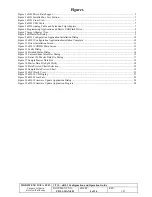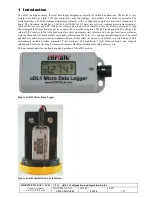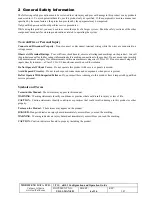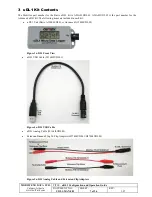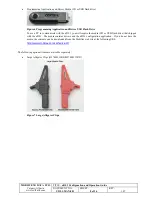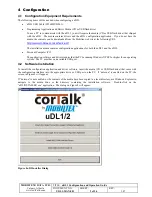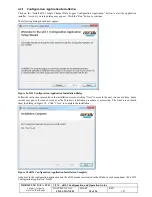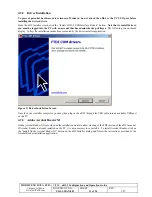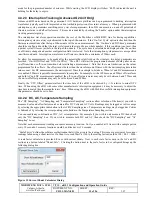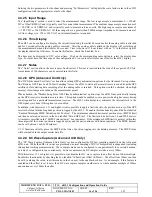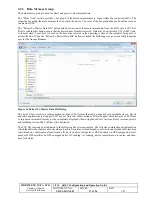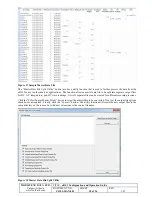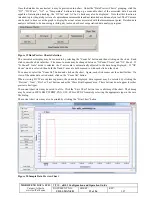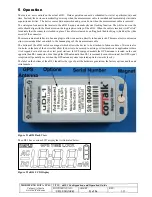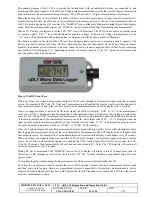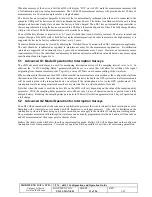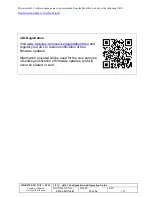
MOBILTEX® DATA LTD.
Calgary, Alberta
www.corTalk.com
TITLE:
uDL1 Configuration and Operation Guide
DOCUMENT NO.:
UDL1-MAN-001
SHEET:
15 of 26
REV:
1.07
mode for the programmed number of minutes. While waiting, the LCD display will show ‘hLD’, indicated the unit is
holding for the delay to expire.
4.3.2.3 Interruption Tracking (Advanced G2 Unit Only)
Advanced uDL1 units based on the generation 2 (G2) hardware platform can be programmed to tracking interruption
waveforms typically used with impressed current cathodic protection close interval surveys. When programmed with
interruption cycle parameters matching survey waveform parameters, the uDL1 can measure on and off potentials of
structures relative to a half-cell reference. This mode is enabled by checking the ‘Enable’ option under the interruption
tracking parameter group.
The interruption waveform operation matches the rest of the Mobiltex corTalk RMU line for timing capabilities.
Interruption cycles are always synchronized to the top-of-the-minute. If the ‘On-first Cycle’ option is checked, then the
first measurement take after the top-of-the-minute will be an on measurement. The ‘On-time’ and ‘Off-time’ parameters
should be configured such that the total cycle time divides into 60s as a whole number; if this condition is not met, then
a partial cycle will occur just before the top-of-the-minute. The cycle time is calculated and displayed after the on-time
or off-time is changed and another configuration field is selected. Note that interruption cycle parameters are specified
in millisecond units. Interruption waveform on/off times are limited to a minimum of 200ms each.
To allow for measurements to be made after the potential has stabilized on the structure, two delay parameters are
provided, ‘On->Off Offset’ and ‘Off->On Offset’. The uDL1 will wait the programmed amount of delay after an on-
to-off transition or off-to-on transition before initiating a measurement. Note that there are limitations on the values
programmed for the offsets. The offsets must be less than the waveform on/off times with the unit sampling time taken
into account. For DC measurements, the unit requires 150ms for a sample to be taken. When AC and DC measurements
are enabled, 250ms is required for measurements to complete. For example, with a 1000ms on and 500ms off waveform
and both AC and DC measurements enabled, the off-to-on offset parameter may only be set between 0 and 750ms and
the on-to-off offset parameter may only be set between 0 and 250ms.
Finally, the ‘UTC Offset’ parameter allows the time base of the uDL1 to be skewed by +/-5s relative to actual UTC
time. When using the uDL1 with some other manufacturers’ interruption equipment, it may be necessary to adjust the
time base to match the other manufacturers’ time. When using the uDL1 with Mobiltex corTalk interruption equipment,
this parameter should be set to 0ms.
4.3.2.4 DC, AC, Temperature Sampling
The “DC Sampling”, “AC Sampling, and “Temperature Sampling” sections allow selection of the item(s) you wish to
measure. Scale and offset factors can be entered for DC Volts and AC Volts. Readings may be tagged as volts or amps
by selecting the appropriate radio button in the AC/DC Sampling areas. Temperature readings may be tagged as Celsius
or Fahrenheit by selecting the corresponding radio button in the Temperature Sampling section.
You can enable any combination of DC, AC, or temperature. For example if you wish to only measure DC then check
only the “DC Sampling” box. If you wish to measure both DC and AC then check the “DC Sampling” and “AC
Sampling” boxes.
Note that each measurement reading consumes a memory location. So if you enabled all 3 items with a sample period
every 10 seconds, 3 memory locations would be utilized every 10 seconds.
“Scale Factor” defines the software multiplication that will be given to the reading. This is used in most cases for current
readings taken using a shunt resistor. If a shunt is to read 50mV at 100A, the scaling factor would be 100 / 0.05 = 2000.
A scale factor calculator is provided for use with current shunts. Next to each scale factor entry in the AC and DC
sections is a button labeled “Shunt Calc”. Clicking the button next to the scale factor to be configured brings up the
following dialog box:
Figure 15 Current Shunt Calculator Dialog




